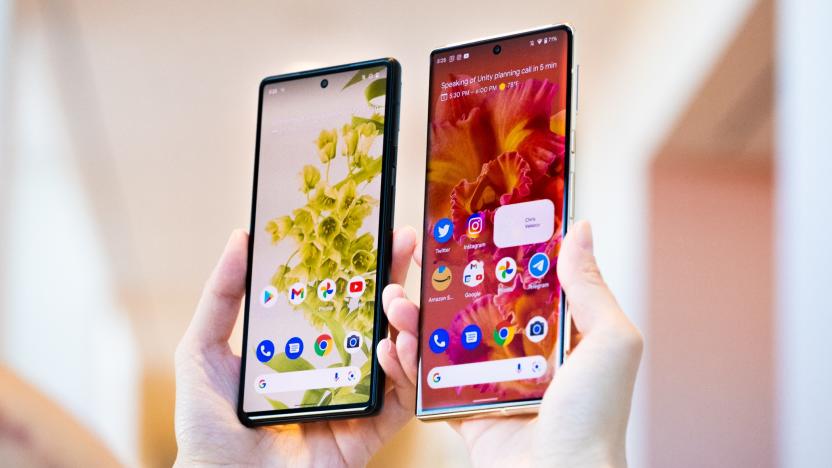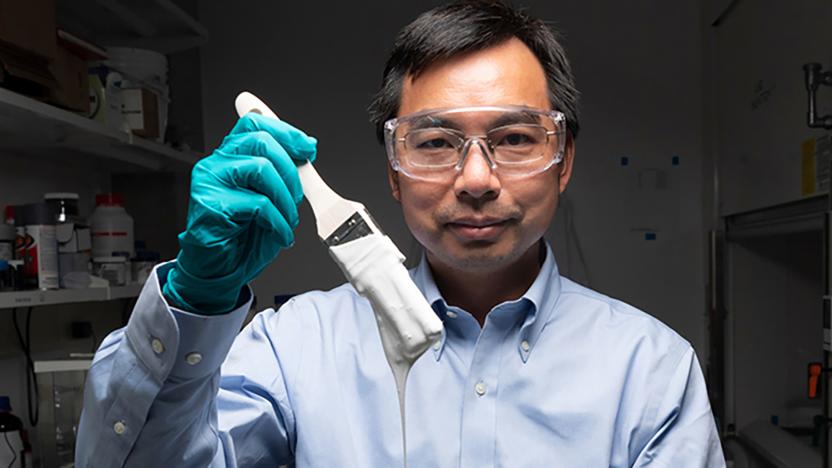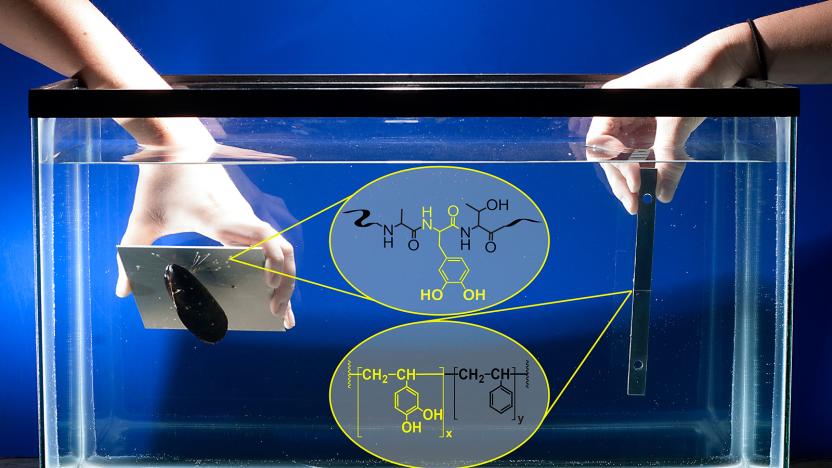Purdue
Latest

Purdue University sues Google over mobile power management tech
Purdue is suing Google over claims the company copied power management code in Android.

Ultra-white paint could reduce the need for air conditioning
Purdue researchers have developed the world's whitest paint, and it could reduce or even eliminate the need for air conditioning.

Starship's delivery robots now serve Purdue University
Starship's delivery robots have reached their largest school campus yet. Purdue students at the university's West Lafayette campus now have the option of ordering robot-delivered food that should arrive in "minutes." As at other schools, deliveries carry a flat $2 fee and work in tandem with your student meal plan. If you're too busy studying to traipse across the university grounds and don't want to spend much more than you're already paying for food, your solution might be at hand.

Gene-edited rice plants could boost the world's food supply
Rice may be one of the most plentiful crops on Earth, but there are only so many grains you can naturally obtain from a given plant. Scientists may have a straightforward answer to that problem: edit the plants to make them produce more. They've used CRISPR/Cas9 gene editing to create a rice plant variety that produces 25 to 31 percent more grain per plant in real world tests, or far more than you'd get through natural breeding. The technique "silenced" genes that improve tolerances for threats like drought and salt, but stifle growth. That sounds bad on the surface, but plants frequently have genetic redundancies -- this approach exploited this duplication just enough to provide all of the benefits and none of the drawbacks.

ICYMI: Submersible sticky situations and elongating elastomer electrodes
Today on In Case You Missed It: Researchers from Purdue University and the Office of Naval Research teamed up to develop a new kind of glue that even works underwater. The synthetic compound is derived from proteins used by muscles to keep themselves attached to rocks. The man-made adhesive is 17 times stronger than its source material and could one day hold US Navy ships together. We also take a look at a stretchable electrode developed at Stanford University. Leveraging the same kind of molecule that commercial kitchens use to thicken soups, the Stanford researchers were able to develop an electrical conductor that can be easily deformed while actually conducting better as it is stretched. And finally, this is what happens when you hook a watermelon up to a car battery. As always, please share any interesting tech or science videos you find by using the #ICYMI hashtag on Twitter for @mskerryd.

Shellfish-inspired glue stays sticky underwater
Even the strongest human-made glue tends to fail when you dunk it underwater. Purdue researchers, however, think they have a simple solution to this: imitate nature. They've developed a polymer adhesive that's based on the proteins mussels use to cling to rocks. The team's synthetic creation takes advantage of compounds inside the proteins' amino acids to bind directly to an intended surface, rather than interacting with water on the surface. The result is a material that not only outperforms the glue you see in the hardware store, but is 17 times stronger than the shellfish's own adhesive -- and that has scientists scratching their heads.

Big Ten Network adds 'League of Legends' to its tournament lineup
The Big Ten Network announced on Thursday that it's adding a less conventional sport to its conference title coverage. Now, in addition to everything from baseball and basketball to football and field hockey, subscribers will be able to see their favorite schools compete against one another in League of Legends. Yeah, the video game.

Researchers could help cops tap into public surveillance cameras
Researchers from Purdue University found a way for law enforcement to tap into any surveillance camera that's not password protected. As Wired points out though, the goal with this newly developed system isn't to help cops perform questionable acts, but rather make it easier for them to figure out how to better assist during a crime or emergency. To make that possible, engineers developed tools smart enough to find open-network surveillance cameras, including public ones, and then send their location to officials who are looking to scan a nearby scene.

Purdue researchers discover how Zika virus is structured
By now, you've probably heard of the Zika fever. You know, the mosquito-carried malady that's been declared an international health emergency and can trigger miscarriage for pregnant women or microcephaly in fetuses. Well, researchers from Purdue University have determined how the virus is structured -- an important step to understanding it and how to guard against the disease. Purdue says that through its research, the team discovered that Zika is structured a lot like other flaviviruses (West Nile virus, tick-borne encephalitis, Dengue virus) which could help speed treatment along.

'Plasmonics' could lead to super-fast optic communications
Researchers at Purdue University have developed a new kind of material that could improve the speed of optical communications by as much as 5000 times the current state of the art. The material is made of aluminum-doped zinc oxide (AZO) and it is able to change the amount of light it reflects by up to 40 percent while consuming a fraction of the power that conventional optical semiconductors consume. By reflecting more or less light, the material can encode and transmit data. What's more, this material operates in the near-infrared spectrum range, which is what is most commonly used in optical communications.

Liquid metal printing puts flexible circuits on 'anything'
Thanks to top universities and some companies, soft robots and stretchy electronics are already a reality. Now a group of researchers from Purdue claim they've found the right manufacturing process to produce those types of devices en masse. Their method entails printing out circuits using an inkjet printer loaded with liquid metal alloy. "This process... allows us to print flexible and stretchable conductors onto anything, including elastic materials and fabrics," said Rebecca Kramer, one of the researchers. After all, if the circuits are made from liquid metal, they can be stretched, folded, squeezed, and so on and so forth, without breaking.

Putting a virtual nose on video games could reduce simulator sickness
Virtual reality can be nauseating. It tricks a part of the brain into believing the body is moving, when it's not. A disconnect between the systems (somatosensory and vestibular, to be precise) can make some people want to throw up. But an ongoing study at Purdue College of Technology suggests that a virtual nose could reduce simulator sickness in video games. When your movement isn't anticipated by the body's perceptual system, it triggers motion sickness. That explains why it's usually a passenger who gets sick in a moving car and not the person driving the car.

Packing peanuts are the key to fast-charging batteries
Hate buying some new gadget, only to wind up with a sea of packing peanuts that do little more than spill on to the floor? Don't be too quick to toss them out -- they may be the key to a new generation of lithium-ion batteries. Purdue University researchers have developed a heating process that converts these shipping leftovers into anodes (where lithium ions are stored during charging) made from carbon. On top of eliminating waste, this technique should lead to batteries that recharge much faster. The carbon anodes are only a tenth as thick as their commercially available counterparts, so they don't produce nearly as much electrical resistance.

Amazon's first staffed pickup spot lets students get textbooks quickly
Sure, Amazon has unmanned delivery lockers to save you the trouble of waiting for a courier, but that human touch could come in handy sometimes. What if you need help with a return, for instance? That's where Amazon's first-ever staffed pickup location, Amazon@Purdue, promises to come to the rescue. The location lets university students and faculty both pick up their online orders and drop off returns (including textbook rentals) in a helpful, trustworthy place -- you shouldn't have to worry about someone swiping your new laptop while you're in class. It's potentially faster, too, as some products qualify for free one-day shipping to the Purdue facility.

University wants you to capture the 'soundscapes' of Earth
Remember when Ridley Scott asked people to record videos to be compiled into the Life in a Day movie? Bryan Pijanowski, Purdue University's Soundscape ecologist, wants to repeat the task today, but with audio rather than video. He's developed the Soundscape Recorder app for iOS and Android and is asking people to suck down three minutes of ambient noise to help measure the changes to the sonic environment. Once you've recorded your moment, you'll be asked to describe what you heard and how it made you feel -- something that Pijanowski hopes will become an annual event every Earth Day. Just don't follow our example and try and record the ambience of an empty room, because that's not helping.

Purdue University's ReadingMate makes the classic reading-running combo a little easier
Universities aren't just places for students to cut classes and enjoy themselves before eventually embarking on careers. They are also places where problems get solved, like the one facing runners who find it hard to read on the jog. That bane is the focus of a group of researchers at Purdue University, who are working on a system called ReadingMate, which moves text on a display in reaction to the bobbing head of a runner to stabilize what's being seen. The screen is sent information from a pair of infrared LED-equipped glasses, but it's not as simple as shifting text in time with head movement -- your eyes are performing corrections of their own, so the words dance slightly out of sync with your noggin to take this into account. It's performed well in testing, and could have applications beyond the gym, such as in heavy machinery and aircraft, where vibration can hamper reading ability in important situations. Those uses make the most sense -- we don't often find ourselves eager to attack that next Twilight chapter during a near-death treadmill experience.

Researchers build optical transistor out of silicon, provide path to all-optical computing
The speed of light is the universal speed limit, so naturally, optical technologies appeal when trying to construct speedy computational devices. Fiber optics let us shoot data to and fro at top speed, but for the time being our CPUs still make their calculations using electronic transistors. Good news is, researchers from Purdue University have built an optical transistor out of silicon that can propagate logic signals -- meaning it can serve as an optical switch and push enough photons to drive two other transistors. It's constructed of a microring resonator situated next to one optical line that transmits the signal, and a second that heats the microring to change its resonant frequency. The microring then resonates at a specific frequency to interact with the light in the signal line in such a way that its output is drastically reduced and essentially shut off. Presto, an optical transistor is born. Before dreams of superfast photonic computers start dancing in your head, however, just know they won't be showing up anytime soon -- the power consumption of such transistors is far beyond their electronic counterparts due to the energy inefficient lasers that power them.

Ghost Pedal: the virtual wah pedal that Rock Band wishes it had (video)
Jimi would be proud. Eight Purdue University students have concocted what's being dubbed a Ghost Pedal; for all intents and purposes, it's a sensor-based processor that's worn around the ankle of the player, and it enables wah-like effects to be commanded from anywhere on stage. Specifically: "The variable resistor sensor records what the user is doing with their ankle, and a sustain sensor either accepts the transmission feed or ignores / sustains it." We're also told that once it's turned on, the user enters a 10-second mode during which the variable resistor calibrates the ability to flex the foot from the floor in a normal pedal motion; after calibration mode, the guitarist enters freeplay mode. As of now, it's available for licensing, and there's a video just past the break to help you make up your mind.

Purdue University creates 'bass' powered medical implant, knows where it hertz
We've seen all kinds of medical implants over the years, but none that had a musical preference -- until now. Researchers at Purdue University have created a pressure sensitive microelectromechanical system (MEMS) that uses sound waves as an energy source. The proof-of-concept has a vibrating cantilever that's receptive to sound -- or music -- in the 200 - 500Hz frequency spectrum, which is towards the bottom end of the audible range. The subcutaneous implant converts the low-frequency vibrations into energy, and then stores it in a capacitor. Once the cantilever stops vibrating, it sends an electrical charge to a sensor and takes a pressure reading, the result is then transmitted out via radio waves for monitoring purposes. The immediate real world applications include diagnosing and treating incontinence, but we're already wondering if that self-powering mp3 player implant could finally become a reality?

This electric wire is four atoms thick, and you thought speaker cable was fiddly (video)
This should come as a great relief to anyone planning a quantum computer self-build: wires still conduct electricity and obey key laws of classical physics even when they're built at the nanoscale. Researchers at Purdue and Melbourne universities used chains of phosphorus atoms inside a silicon crystal to create a wire that's just four atoms wide and a single atom high -- 20 times smaller than the previous record-holder and infinitely narrower than anything you'd find at Newegg. The video after the break almost explains how they did it.











